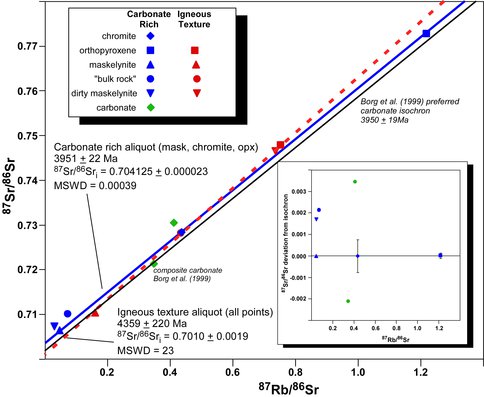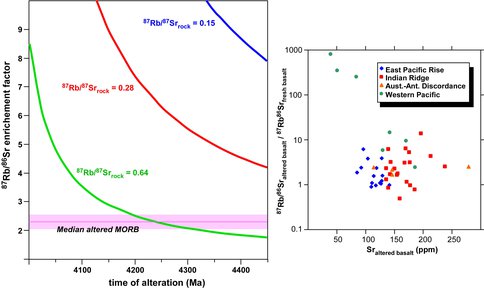2011 Annual Science Report
 University of Wisconsin
Reporting | SEP 2010 – AUG 2011
University of Wisconsin
Reporting | SEP 2010 – AUG 2011
Project 1A: Rb-Sr Geochronology of ALH84001 Demonstrates Early Weathering on Mars
Project Summary
Rb-Sr geochronology on martian meteorite ALH8400 reveals that an igneous-textured zone within the meteorite yields a mineral isochron consistent with a young 4.1 Ga age for igneous crystallization. In contrast, a mineral isochron from a carbonate-rich zone in the meteorite defines an age of 3951 Ma, which is concordant with the time of carbonate formation and is interpreted as a shock-resetting event. Carbonate from the rock has unusually high initial 87Sr/86Sr ratios and such high ratios require interaction with that were derived from weathered bedrock that had high Rb/Sr, most likely clay alteration products. This places a powerful constraint on the timing of clay weathering on Mars at >4.0 Ga.
Project Progress
Martian meteorite ALH84001 has played a critical role in shaping the NASA Astrobiology Institute. Based on the suggestion that this meteorite contained evidence for past life on Mars (McKay et al., 1996), the scientific community was spurred to develop methods to identify past life in the solar system. This scientific need, in part, led to the creation of the NAI. Critical research over the past one and half decade by NAI workers, and others, has largely shown that nearly all of the features suggested to be biogenic in ALH84001 are better explained by abiologic processes on Mars or by terrestrial contamination. Never the less, this meteorite is important to martian history because it is considered to be the oldest of all the known martian meteorites, and thus provides a unique perspective on early martian history when condition were likely to be the most conducive to habitability. Our past work on this meteorite has focused on evaluating the igneous crystallization of this sample using the Lu-Hf and Sm-Nd isotope systems (Lapen et al., 2010). This research, as well as other studies that used 206Pb-207Pb and 39Ar/40Ar (refs), showed that this sample crystallized at 4.1 Ga as compared to initial research that inferred an age of 4.5 Ga based on Sm-Nd investigations (Refs).
Our current work focuses on using the Rb-Sr isotope system to evaluate the geochronology of this meteorite and to better constrain the chemical composition of the fluids that precipitated the unusual carbonate globules contained in ALH84001. Rb-Sr isotope data has been collected on mineral separates from an igneous textured and a carbonate-rich aliquot of Martian meteorite ALH84001. The igneous textured aliquot defines an imprecise isochron of 4359 ±220 Ma (Figure 1) that could be consistent with igneous crystallization at either 4.5 Ga as determined by Sm-Nd geochronology, or a younger 4.1 Ga age defined by Lu-Hf and 206Pb-207Pb systematics. The high initial 87Sr/86Sr ratio of the igneous aliquot isochron, however, is more consistent with a young crystallization age because an old age would require derivation from a mantle source with an impossibly high 87Rb/86Sr ratio. The carbonate-rich aliquot defines a precise Rb-Sr isochron between maskelynite, orthopyroxene and chromite of 3951 ± 22 Ma (Figure 1) and this is interpreted to represent a shock resetting event that is coeval with carbonate precipitation (Borg et al., 1999). Carbonate, bulk rock and impure mineral separates all have high 87Sr/86Sr (Figure 1).
This high carbonate 87Sr/86Sr ratio can only be produced by a secondary alteration event in which the fluids that precipitated carbonate in ALH84001 had interacted with older high Rb/Sr rocks which had relatively high 87Sr/86Sr ratios. Weathering of preexisting rocks to phyllosilicates prior to 3950 Ma is deemed the most likely method to allow fluids to equilibrate with rocks that have high 87Sr/86Sr ratios. Indeed, these high 87Sr/86Sr ratios measured in carbonate, provide strong evidence for a wet Mars with active weathering processes producing phyllosilicates by 4250Ma assuming Rb/Sr enrichments similar to that observed for altered terrestrial mid ocean ridge basalts (Figure 2).
Rb-Sr isochron plot of the carbonate-rich and igneous textured aliquots from ALH84001. For reference the preferred carbonate isochron of (Borg et al., 1999) and an integrated carbonate composition from this isochron are plotted. Inset shows the deviation of phases from the carbonate-rich orthopyroxene-chromite-maskelynite isochron.
Plot of the 87Rb/86Sr enrichment ratio required to produce the 87Sr/86Sr of carbonate analyzed in this study at 3950 Ma as a function of time. The different curves reflect different 87Rb/86Sr ratios which controls the initial 87Sr/86Sr because of radiogenic decay of 87Rb to 86Sr from 4513Ma to the time corresponding to the x-axis. Inset shows the 87Rb/86Sr enrichment factor (log-scale) for different mid ocean ridge basalts that have been variably altered as a function of the Sr concentration measured in the altered basalt. Enrichment factors calculated based on normalizing the Rb/Sr ratio of an altered sample to an area in the sample that is least altered samples (ALT and TEAGLE, 2003; BACH et al., 2001; KROLIKOWSKA-CIAGLO et al., 2005; SCHRAMM et al., 2005).
Publications
-
Beard, B. L., Ludois, J. M., Lapen, T. J., & Johnson, C. M. (2013). Pre-4.0 billion year weathering on Mars constrained by Rb–Sr geochronology on meteorite ALH84001. Earth and Planetary Science Letters, 361, 173–182. doi:10.1016/j.epsl.2012.10.021
-
PROJECT INVESTIGATORS:
-
PROJECT MEMBERS:
Clark Johnson
Co-Investigator
Tom Lapen
Collaborator
Jim Ludois
Graduate Student
-
RELATED OBJECTIVES:
Objective 2.1
Mars exploration.


